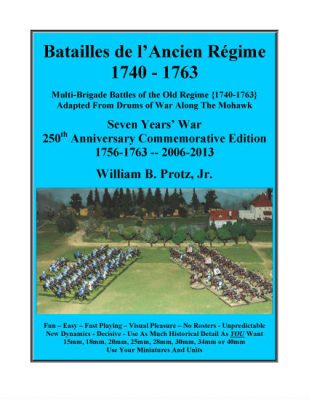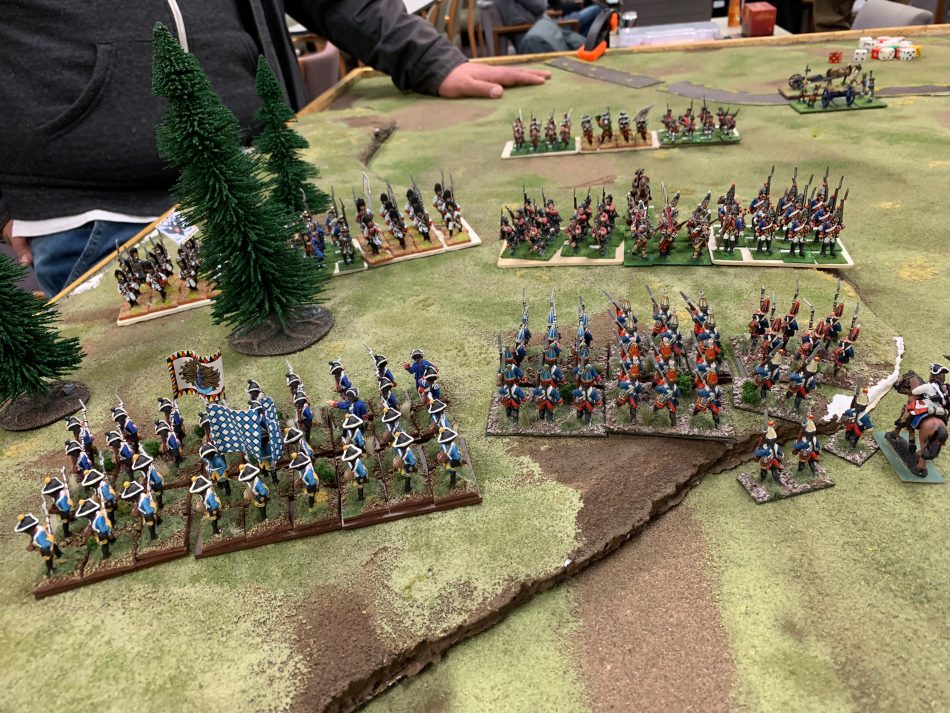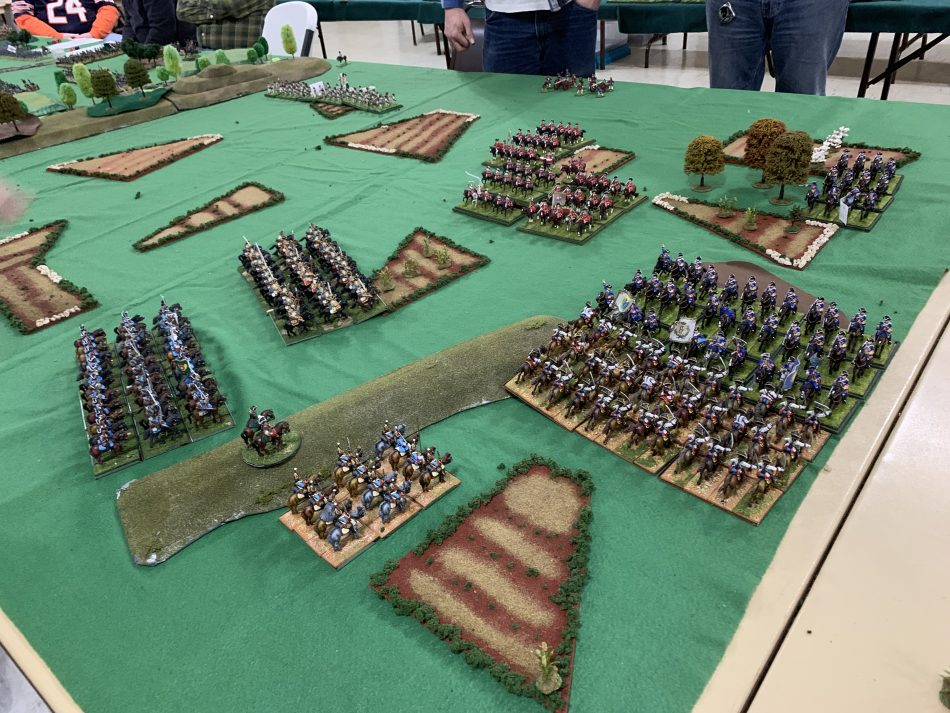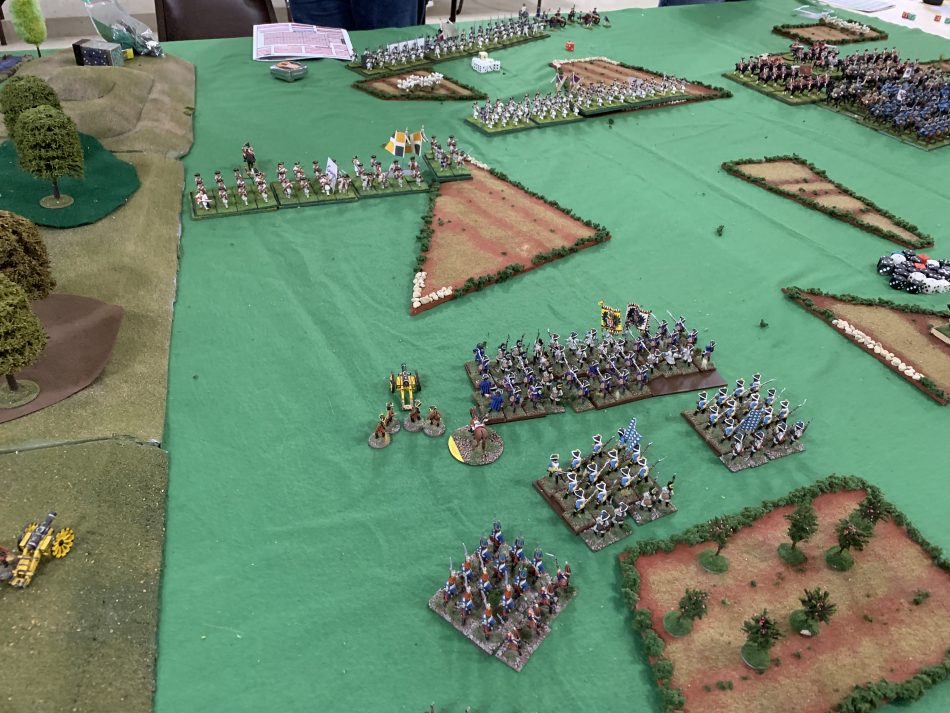BAR: Batailles de l’Ancien Régime
 to its fans is a great horse and musket game for the Seven Years War. This is approximately the years 1740-1763. The war itself started in 1754 and lasted until 1763. As was with the times in Europe it was turbulent with many factions and thus a good topic for action on the tabletop. For those of us within the United States, we know this war as the French and Indian War when the young George Washington was a junior officer with the British Army.
to its fans is a great horse and musket game for the Seven Years War. This is approximately the years 1740-1763. The war itself started in 1754 and lasted until 1763. As was with the times in Europe it was turbulent with many factions and thus a good topic for action on the tabletop. For those of us within the United States, we know this war as the French and Indian War when the young George Washington was a junior officer with the British Army.
This set of rules is more for Europe, and the author Bill Protz has another set of rules specifically for the French and Indian Wars called
Let’s talk about BAR, what makes it fun and why it might be the game you’re looking for. This period in history has much to offer. Across Europe the political map was complex and the variety of forces involved and their fickle loyalties offer many a what if as well as historical material to plan a game.
The time period is one where the uniforms are, dare I say, pretty?
BAR, in particular, is one of those games where your ability to execute period tactics will reward you. Mix in some luck with many a die roll for musket fire or melee combat or perhaps see your plans thwarted as you fail critical moral rolls as your men have done their bit for the day. When playing you’re going to feel like you’re there, hearing the drum beat, the roar of the cannon and the shouts of orders by the officers to their men. This is the type of game I live for and I think you’ll highly enjoy.
 Here are my Austrians facing up against some British at a recent one-off game at D6 Games in Rochester Mn.
Here are my Austrians facing up against some British at a recent one-off game at D6 Games in Rochester Mn.
Note the unit on the right closest to the camera, Grenadiers having been massed together ready to fire a volley. They were the better troops being well supplied, better trained and more trusted to hold to their orders at pivotal times in the battle. Their uniform equally communicates their status.
Those new to the period hopefully will be inspired to do a little reading. Thankfully there are a number of sites across the internet that can get you up to speed besides just the usual Wikipedia. I like due to their unit histories and other information that I generally need when painting up units. As I hinted at earlier, there is a rich environment of history and unit histories to be modeled on the tabletop. Unique flags, uniforms, it’s all there. No codex to buy. No oddball rules. Just history to absorb. Eg
Basic Elements of the Game
A basic infantry unit on the field represents a regiment. When planning a game you scale this up or down, a 60 figure regiment is quite large but impressive on the tabletop, and 30 figure regiments more reasonable. I recommend 30 with some variability, after all, not all units were the same size.
Cavalry units are generally about 12 figures to a squadron, with about 4 squadrons to a regiment.
The selected number of figures in a regiment and scale directly influences the size of tabletop you’ll need for a game. We play in 28mm and a large table like a 9’x6′ gives your forces important room to roam and allows you to perform period tactics which are essential to victory. In this day and age, not everyone has that size of a table in their game room or available at your friendly local game store. Plan ahead!
BAR does have a point costing system to assemble an army. There are those that want to just show up with an agreed to amount of points and play, not worrying about putting on some historical action. BAR covers that. For those that want to do something a little more historical, BAR offers a good framework for you to do so. As a hint, I’ll point at the of Orders of Battle that might be of use to you planning historical games.
Another type of play that we see locally players create “imagi-Nations” where they put themselves into the role of a minor kingdom that is able to raise its own army. Painting and organizing their force as they like and settling their squabbles on the battlefield as the final argument of kings. It’s a fun way to play a series of loosely connected actions with at least a little storyline behind it, if not some personal honor to defend. Much like the Kings if the day after a battle you’ll start to wonder things like if I only had another regiment or two…
The Turn
A turn is broken into roughly three stages. Movement, Fire and then Melee. Units are activated to move by using a deck of cards to select which side goes first. Black indicates one side, red the other. Jokers matter. Smaller games you might activate a single regiment per card, larger games a whole brigade. If a Joker comes up that is awarded to a side and can be used at a future point in time to interrupt the other side allowing you a tactical advantage to do as you like at some hopefully critical point in the game. Fire first or get a charge in, that kind of thing.

Here a massive cavalry scrum is about to ensue, where the winner might turn the flank or dive deep behind enemy lines causing all sorts of chaos.
Cavalry has three speeds of movement from a trot to a gallop. The higher the s, especially in a charge situation, will help give you positive modifiers as you hit the enemy. The quick reference sheets support two scales. In 28mm a full-on gallop is 30″ + 1D6″ of moment.
For infantry at 28mm, a full move is 16″ which tends to be plenty to be able to maneuver and importantly get into battle without taking hours of build up before actually doing anything on the tabletop.
I strongly recommend you build movement trays for your forces. Use magnets so your figures “stick” to the trays. That way you can move a force efficiently and quickly keeping play fast.
On the back of the quick reference sheets is an essential “drill manual” and shows you just how units in this era would move. Infantry forming line of battle or marching in column are some of the essential tools of the trade you’ll need to learn.
Fire is once again decided by a draw of the card to determine who gets to shoot first. As a commander, you need to look across the battlefield and decide what is most important.
Getting the drop on your opponent might allow you to deliver that devastating volley that then causes their regiment to rout away, leaving a hole in their lines for you exploit in a later turn.
 Firing is accomplished by determining how many figures you have in an infantry regiment. Multiples of 20 or smaller numbers. For example, if you have a 30 figure regiment, you break that down into 2 groups of 15 figures. For each group of 15, you’ll roll 2D6 and apply some set of modifiers, such as minus for movement, or first fire, quality of troops and so on. Each 2D6 result will get you to some number of potential casualties the other side will need to resolve.
Firing is accomplished by determining how many figures you have in an infantry regiment. Multiples of 20 or smaller numbers. For example, if you have a 30 figure regiment, you break that down into 2 groups of 15 figures. For each group of 15, you’ll roll 2D6 and apply some set of modifiers, such as minus for movement, or first fire, quality of troops and so on. Each 2D6 result will get you to some number of potential casualties the other side will need to resolve.
Your opponent rolls a D6 for each potential casualty. For infantry fire, a 1-3 is a loss of a figure, and 4-6 is a save. Fire is quick to resolve, kind of a bucket of dice but with either good or bad luck, decisive. If your target has lost 50% or 75% of their figures from when they first took the field, they’ll have to take a morale check. If they fail, they’ll rout away.
The last part of a turn is Melee, which resolves those units that have charged into each other. It uses much the same system as firing to determine casualties using again a 2D6 system. The modifiers are however different which takes into account things like being charged in the flank or disorder and so on which are critical for a charge.
Win a melee and your opponent will hopefully rout away giving you a precious opportunity that fortune might allow you to successfully exploit thus winning honor on the battlefield.
Figures
BAR takes no position as far as having to use official figures. It’s left to you to pick up lead/plastic as you like. There are a number of great companies out there that make wonderful 28mm lead or plastic. Another popular scale is 15mm, regardless there are lots to choose from.
Some of my favorites include :
Please do some shopping, visit a convention, and especially order via your friendly local game store when you can, after all, they need to keep the lights on and it is by playing games at your friendly local game store that you can meet others that have similar interests which importantly gives you future opponents.
Setting a nice table
With 3D printing or companies like , you’ve lots of options to create a pretty tabletop experience without having to put much effort into it. While you can create a positively exquisite table, too much and you’ll hinder play. Besides, consider the time to takes to setup and take down your game.
 Remember the great generals of the time would do their best to pick where to give battle. They needed space to maneuver their cavalry and infantry. Canon in order to be able to fire at range needs lanes of fire.
Remember the great generals of the time would do their best to pick where to give battle. They needed space to maneuver their cavalry and infantry. Canon in order to be able to fire at range needs lanes of fire.
Fighting in the middle of a town or deeply forested area was not conducive to achieving victory.
With BAR less is more when it comes to terrain. Roads, fields, fences, some trees here and there is good enough.
Play Aids
The rules come with a great 4 page quick reference sheet that will keep you from having to consult the rules. They are well put together, guide you through the modifiers and flow for the various parts of a turn.
The rules themselves are 72 pages in length. There is an errata and followup set of information that is online and .
Finis
BAR has been around for 11 years, it’s a positive favorite in the US Midwest for the Seven Years War time period. These are a set of rules that I highly recommend. They are fun. The games are dramatic and flowing. The period tactics are well represented. The chaos of the battlefield for you through your command to rise to glory or suffer defeat is all there. Importantly, you are able to play an afternoon and get to a result.
Many a person that walks by this game can’t help themselves to be drawn in to know more about it.
I can’t think of a better set of qualities that when combined inspire me to wanting to play again and again.

Nicely done. A fair and balanced representation of the action. Nothing like the look of “big battalions” on the game table.